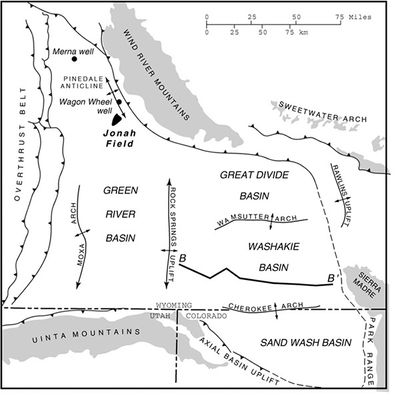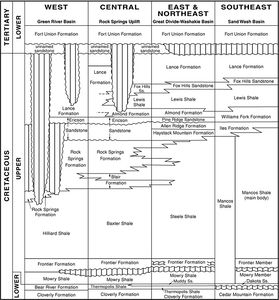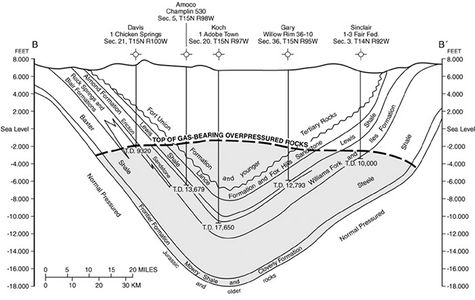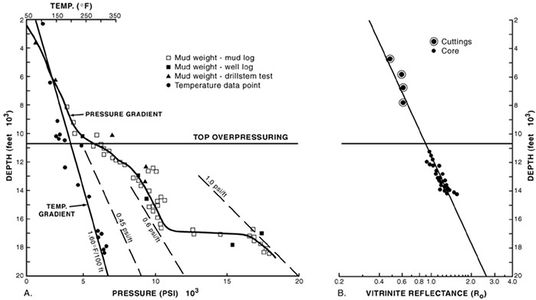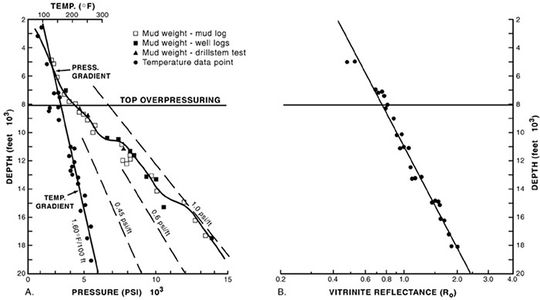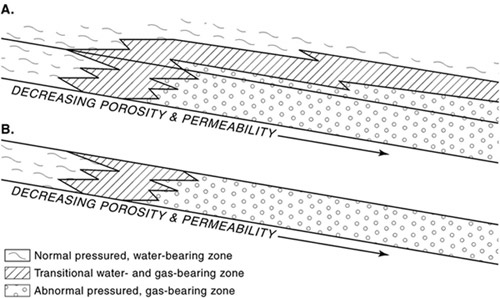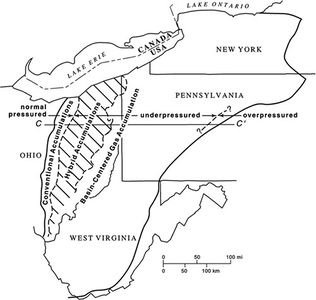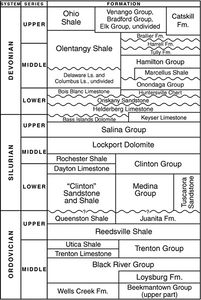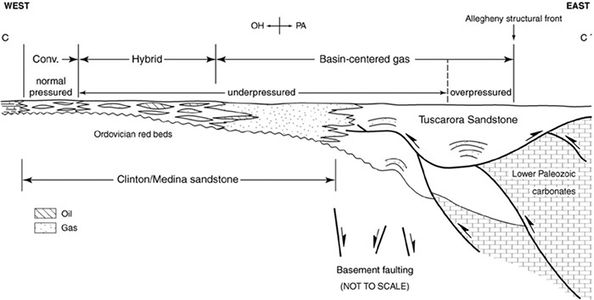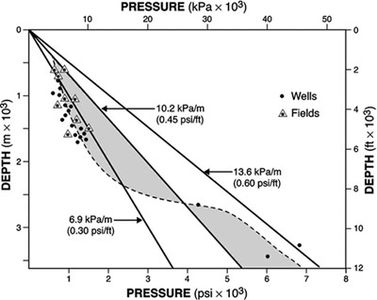Basin-centered gas systems: examples
| Basin-centered gas systems | |
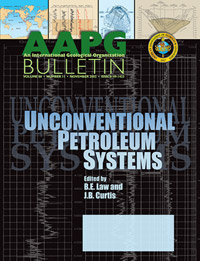
| |
| Series | AAPG Bulletin, November 2002 |
|---|---|
| Author | Ben E. Law |
| Link | Web page |
To illustrate the elements and processes of direct and indirect basin-centered gas systems (BCGSs), an example of each system is included in the following discussion. Additional examples are provided in Table 1 of the Basin-centered gas systems: development article.
Direct type: Greater Green River basin[edit]
The Greater Green River basin, located in southwestern Wyoming (Figure 1), is one of several foreland basins in the Rocky Mountain region containing BCGSs. The stratigraphic interval containing the BCGS includes all of the Cretaceous sequence, locally extending into lower Tertiary rocks. Stratigraphic correlations of lower Tertiary and Cretaceous rocks in the Greater Green River basin are shown in Figure 2. For a comprehensive discussion of the stratigraphy and structure of the basin see Ryder.[1] Estimates of in-place gas resources contained in the basin-centered gas accumulation (BCGA) within Cretaceous and Tertiary rocks are as large as 5063 tcf,[2] and the mean estimate of recoverable gas is 119.3 tcf.[3] Additional references to a BCGS in the Greater Green River basin include publications by Law et al.,[4][5] McPeek,[6] Davis,[7] Law,[8] Keighin et al.,[9] Law and Spencer,[10] Spencer,[11] Surdam,[12] Garcia-Gonzales et al.,[13][14] MacGowan et al.,[15] and Surdam et al.[16]
General characteristics of the Greater Green River basin BCGS[edit]
- Area: 19,700 mi2 (51,000 km2)
- Source rocks: Upper Cretaceous and lower Tertiary coal beds and carbonaceous shales in the Fort Union, Lance, Almond, and Rock Springs formations. Organic matter is largely gas-prone type III kerogen[8] with additional contribution from thermally cracked oils sourced from sapropelic coal beds.[13][14][15][17]
- Generation-expulsion-migration: late Eocene-late Oligocene (40-25 Ma)
- Reservoir rocks: Cretaceous to lower Tertiary sandstones. Multiple, stacked reservoirs occur in rock intervals as thick as 14,000 ft (4267 m) (Figure 3). Individual reservoirs range in thickness from 15 to 125 ft (4.6-38 m). Gas reservoirs are saturated and contain water at irreducible levels. The gas-bearing interval does not commonly contain interbedded, water-bearing reservoirs.
- Porosity: <13%
- Permeability: <0.1 md (in-situ)
- Environments of deposition: mainly fluvial dominated and, to a lesser degree, marginal marine deltaic and barrier bar
- Reservoir pressure: overpressured, with gradients ranging from 0.5 to 0.9 psi/ft (Figure 4, Figure 5)[4][5][6][7][8][18][11][17]
- Seals: Regional seals are capillary pressure seals. Locally, structural and stratigraphic seals are important.
- Gas accumulations: downdip from normally pressured, water-bearing reservoirs (Figure 6);[8][19] lacks a downdip water contact.[8] The level of thermal maturity at top of accumulation ranges from 0.7 to 0.9% Ro[8] (Figure 4, Figure 5), commonly 0.8% Ro.[8]
- Depth to accumulation: ranges from 8000 to 11,500 ft (2438-3505 m)
- Gas quality: Gas is of a thermal origin and generally composed of >90% methane, <5% ethane and higher homologs, <5% carbon dioxide, and negligible nitrogen. Condensate ranges from <5 to 70 bbl/mmcf gas.
- Sweet spots: structural and stratigraphic
Figure 2 Generalized stratigraphic correlation chart of Cretaceous and lower Tertiary rocks in the Greater Green River basin, Wyoming and Colorado (modified from Law et al.[2])
Figure 4 (A) Pressure and temperature and (B) vitrinite reflectance gradients for the Belco 3-28 Merna well, northern Green River basin, Wyoming (from Law,[8] reprinted by permission of the Rocky Mountain Association of Geologists). Location of well shown on Figure 1. Pressure gradient interpreted by C. W. Spencer.
Indirect type: Lower Silurian Clinton-Medina-Tuscarora, Appalachian Basin[edit]
The Lower Silurian Clinton-Medina-Tuscarora BCGS, located in the Appalachian basin (Figure 7, Figure 8), is one of the better documented examples of an indirect BCGS. Estimates of recoverable resources range from 8.0 to 30.3 tcf.[20][21] For additional discussions of the Clinton-Medina-Tuscarora, refer to investigations by Davis,[7], Law and Dickinson,[22] Laughrey and Harper,[23] Zagorski,[24][25] Law et al.,[26] Ryder,[27] and Ryder and Zagorski.[28]
Figure 5 (A) Pressure and temperature and (B) vitrinite reflectance gradients in the El Paso Natural Gas 1 Wagon Wheel well, northern Green River basin, Wyoming (from Law,[8] reprinted by permission of the Rocky Mountain Association of Geologists). Location of well shown on Figure 1. Pressure gradient interpreted by C. W. Spencer.
Figure 7 Location of Clinton-Medina-Tuscarora basin-centered gas system in the Appalachian basin, showing the normally pressured, underpressured, and overpressured parts of the system, as well as areas of conventional, hybrid, and BCGA production. Cross section CC' shown on Figure 9. Modified from Ryder and Zagorski.[28]
General characteristics of the Lower Silurian Clinton-Medina-Tuscarora, Appalachian Basin BCGS[edit]
- Area: Clinton-Medina part is 45,000 mi2 (116,550 km2); Tuscarora part is 30,000 mi2 (77,700 km2).
- Source rock: Ordovician Utica Shale.[29][30][31][32] The Utica Shale contains type II kerogen and is thermally overmature (>1.3% Ro).
- Generation-migration-accumulation: Late Devonian-Early Mississippian (370-320 Ma)[30][33][34][32][28]
- Reservoir rocks: Lower Silurian Clinton-Medina in eastern Ohio and western Pennsylvania and Tuscarora Sandstone in central Pennsylvania. The reservoir interval ranges in thickness from 100 to 600 ft (30-183 m).[28] The thermal maturity of the reservoir ranges from 1.1 to 2.0% Ro.[35]
- Porosity: 5-10%[27][28]
- Permeability: <0.1 md[27][28]
- Environments of deposition: Fluvial, estuarine, and inner marine shelf in the eastern part to outer marine shelf and tidal in the western part[36][37][38]
- Reservoir pressure: Reservoirs are normally pressured in the updip part of the Clinton-Medina in eastern Ohio, producing oil, gas, and water (Figure 7, Figure 9). In western Pennsylvania reservoirs are underpressured and produce mainly gas with very small amounts of water (Figure 7, Figure 9). Ryder and Zagorski[28] reported pressure gradients of 0.39-0.25 psi/ft in the underpressured part of the system. In central Pennsylvania, the Tuscarora Sandstone, equivalent to the Clinton-Medina, is overpressured and produces gas with small amounts of water (Figure 7, Figure 9). Ryder and Zagorski[28] reported pressure gradients ranging from 0.50 to 0.60 psi/ft in the overpressured Tuscarora Sandstone in central Pennsylvania. The variable pressure gradients within the stratigraphic interval are shown in Figure 10.
- Seals: The top seal is interpreted to be the shales, carbonates, and evaporites in the overlying Upper Silurian.[30] The updip seal has been identified as a water block.[24][25][28]
- Gas accumulations: Downdip from normally pressured, water-bearing reservoirs; lacks downdip water contact (Figure 9)
- Depth to accumulation: 6500 ft (1981 m) in western Pennsylvania to 12,000 ft (3658 m) in central Pennsylvania[28]
- Gas quality: Gas is interpreted to be a product of thermally cracked oil.[22][39][26][28] Gas in the Clinton-Medina sandstone is generally composed of 79-94% methane; 3-12% ethane, propane, and C4+ hydrocarbon; and 3-9% nitrogen and carbon dioxide.[31][28] In the Tuscarora Sandstone, gas is commonly dry (C1/C1-5 = 0.98-0.99), with nitrogen and carbon dioxide contents of 4-22% and <1-83%, respectively.[28]
- Sweet spots: structural and stratigraphic
Figure 8 Geologic column of Ordovician-Devonian rocks in eastern Ohio and western Pennsylvania, Appalachian basin (modified from Law and Spencer[39]).
Figure 9 Generalized cross section CC' showing normally pressured, underpressured, and overpressured parts of the Clinton-Medina-Tuscarora interval (modified from Ryder and Zagorski[28]). The underpressured and overpressured areas of the Clinton-Medina-Tuscarora represent the indirect BCGA part of the interval where gas and minor amounts of water are produced, and the normally pressured area represents the conventional part of the interval where oil, gas, and water are produced. The hybrid, underpressured area represents transition from oil, gas, and water production in eastern Ohio to gas and minor water production in the BCGA.
Figure 10 Composite pressure gradient showing pressure end members (normal, underpressuring, and overpressuring relationships) within the Clinton-Medina-Tuscarora interval (modified from Law et al.[26]).
The underpressured reservoirs in the Clinton-Medina are interpreted to have undergone an earlier overpressured phase caused by the thermal transformation of oil to gas.[22][39][26][28] Later, during a period of regional uplift accompanied by loss of gas and reservoir cooling, the overpressured, gas-bearing Clinton-Medina underwent a transition to an underpressuring phase. The overpressured, gas-bearing Tuscarora Sandstone reservoirs in central Pennsylvania are interpreted to be pressure remnants of the earlier overpressured phase in the Clinton-Medina.[26][28]
References[edit]
- ↑ Ryder, R. T., 1998, Greater Green River basin, in L. L. Sloss, ed., Sedimentary cover-North America craton: The Geology of North America, v. D-2, p. 154-165.
- ↑ 2.0 2.1 2.2 Law, B. E., C. W. Spencer, R. R. Charpentier, R. A. Crovelli, R. F. Mast, G. L. Dolton, and C. J. Wandrey, 1989, Estimates of gas resources in overpressured low-permeability Cretaceous and Tertiary sandstone reservoirs, Greater Green River basin, Wyoming, Colorado, and Utah: 40th Annual Field Conference, Wyoming Geological Association Guidebook, p. 39-61.
- ↑ Law, B. E., 1996, Southwestern Wyoming province (037), in D. L. Gautier, G. L. Dolton, K. I. Takahashi, and K. L. Varnes, eds., 1995 national assessment of United States oil and gas resources-results, methodology, and supporting data: U.S. Geological Survey Digital Data Series DDS-30, Release 2, 1 CD-ROM.
- ↑ 4.0 4.1 Law, B. E., C. W. Spencer, and N. H. Bostic, 1979, Preliminary results of organic maturation, temperature, and pressure studies in the Pacific Creek area, Sublette County, Wyoming, in 5th Department of Energy symposium on enhanced oil and gas recovery and improved drilling methods, v. 3-oil and gas recovery: Tulsa, Oklahoma, Petroleum Publishing, p. K-2/1-K-2/13.
- ↑ 5.0 5.1 Law, B. E., C. W. Spencer, and N. H. Bostick, 1980, Evaluation of organic maturation, subsurface temperature, and pressure with regard to gas generation in low-permeability Upper Cretaceous and lower Tertiary strata in the Pacific Creek area, Sublette County, Wyoming: Mountain Geologist, v. 17, no. 2, p. 23-35.
- ↑ 6.0 6.1 McPeek, L. A., 1981, Eastern Green River basin-a developing giant gas supply from deep, overpressured Upper Cretaceous sandstones: AAPG Bulletin, v. 65, p. 1978-1098.
- ↑ 7.0 7.1 7.2 Davis, T. B., 1984, Subsurface pressure profiles in gas saturated basins, in J. A. Masters, ed., Elmworth-case study of a deep basin gas field: AAPG Memoir 38, p. 189-203.
- ↑ 8.0 8.1 8.2 8.3 8.4 8.5 8.6 8.7 8.8 Law, B. E., 1984, Relationships of source rocks, thermal maturity, and overpressuring to gas generation and occurrence in low-permeability Upper Cretaceous and lower Tertiary rocks, Greater Green River basin, Wyoming, Colorado, and Utah, in J. Woodward, F. F. Meissner, and J. L. Clayton, eds., Hydrocarbon source rocks of the greater Rocky Mountain region: Rocky Mountain Association of Geologists Guidebook, P. 469-490.
- ↑ Keighin, C. W. B. E. Law, and R. M. Pollastro, 1989, Petrology and reservoir characteristics of the Almond Formation, Greater Green River basin, Wyoming, in E. B. Coalson, S. S. Kaplan, C. W. Keighin, C. A. Oglesby, and J. W. Robinson, eds., Petrogenesis and petrophysics of selected sandstone reservoirs of the Rocky Mountain region: Rocky Mountain Association of Geologists, p. 281-294.
- ↑ Law, B. E., and C. W. Spencer, eds., 1989, Geology of tight gas reservoirs in the Pinedale anticline area, Wyoming and at the Multiwell Experiment site, Colorado: U.S. Geological Survey Bulletin 1886, p. 39-61.
- ↑ 11.0 11.1 Spencer, C. W., 1989, Comparison of overpressuring at the Pinedale anticline area, Wyoming, and the Multiwell Experiment site, Colorado, in B. E. Law and C. W. Spencer, eds., Geology of tight gas reservoirs in the Pinedale anticline area, Wyoming and at the Multiwell Experiment site, Colorado: U.S. Geological Survey Bulletin 1886, 16 p.
- ↑ Surdam, R. C., 1992, Sandstone geometries, petrophysical characteristics, and pressure regimes, Mesaverde Group, Green River basin, Wyoming, in C. E. Mullen, ed. Rediscover the Rockies: Wyoming Geological Association Forty-third Field Conference, p. 167-169.
- ↑ 13.0 13.1 Garcia-Gonzales, M., D. B. MacGowan, and R. C. Surdam, 1993, Coal as a source rock of petroleum and gas-a comparison between natural and artificial maturation of the Almond Formation coals, Greater Green River basin in Wyoming, in D. G. Howell, ed., The future of energy gases: U.S. Geological Survey Professional Paper 1570, p. 405-437.
- ↑ 14.0 14.1 Garcia-Gonzales, M., D. B. MacGowan, and R. C. Surdam, 1993, Mechanisms of petroleum generation from coal, as evidenced from petrographic and geochemical studies: Examples from Almond Formation coals in the Greater Green River basin, in B. Strook and S. Andrew, eds., Wyoming Geological Association Jubilee Anniversary Field Conference Guidebook, p. 311-323.
- ↑ 15.0 15.1 MacGowan, D. B., M. Garcia-Gonzales, D. R. Britton, and R. C. Surdam, 1993, Timing of hydrocarbon generation, organic-inorganic diagenesis, and the formation of abnormally pressured gas compartments in the Cretaceous of the Greater Green River basin: A geochemical model, in B. Strook and S. Andrew, eds., Wyoming Geological Association Jubilee Anniversary Field Conference Guidebook, p. 325-357.
- ↑ Surdam, R. C., J. Robinson, Z. S. Jiao, and N. K. Boyd III, 2001, Delineation of Jonah field using seismic and sonic velocity interpretations, in D. S. Anderson, J. W. Robinson, J. E. Estes-Jackson, and E. B. Coalson, eds., Gas in the Rockies: Rocky Mountain Association of Geologists, p. 189-208.
- ↑ 17.0 17.1 Surdam, R. C., Z. S. Jiao, and H. P. Heasler, 1997, Anomalously pressured gas compartments in Cretaceous rocks of the Laramide basins of Wyoming: A new class of hydrocarbon accumulation, in R. C. Surdam, ed., Seals, traps, and the petroleum system: AAPG Memoir 67, p. 199-222.
- ↑ Spencer, C. W., 1987, Hydrocarbon generation as a mechanism for overpressuring in Rocky Mountain region: AAPG Bulletin, v. 71, p. 368-388.
- ↑ Spencer, C. W., 1985, Geologic aspects of tight gas reservoirs in the Rock Mountain region: Journal of Petroleum Geology, p. 1308-1314.
- ↑ Gautier, D. L., G. L. Dolton, K. I Takahashi, and K. L. Varnes, eds., 1996, 1995 national assessment of United States oil and gas resources-results, methodology, and supporting data: U.S. Geological Survey Digital Data Series DDS-30, RElease 2, 1 CD-ROM.
- ↑ McCormac, M. P., G. O. Mychkovsky, S. T. Opritza, R. A. Riley, M. E. Wolfe, G. E. Larson, and M. T. Baronoski, 1996, Play Scm: Lower Silurian Cataract/Medina Group ("Clinton") sandstone play, in J. B. Roen and B. J. Walker, eds., The atlas of major Appalachian gas plays: West Virginia Geological and Economic Survey Publication V-25, p. 156-163.
- ↑ 22.0 22.1 22.2 Law, B. E., and W. W. Dickinson, 1985, A conceptual model for the origin of abnormally pressured gas accumulations in low-permeability reservoirs: AAPG Bulletin, v. 69, p. 1295-1304.
- ↑ Laughrey, C. D., and J. A. Harper, 1996, Play Obe: Upper Ordovician Bald Eagle Formation fractured play, in J. B. Roen and B. J. Walker, eds., The atlas of major Appalachian gas plays: West Virginia Geological and Economic Survey Publication V-25, p. 164-167.
- ↑ 24.0 24.1 Zagorski, W. A., 1988, Exploration concepts and methodology for deep Medina sandstone reservoirs in northwestern Pennsylvania (abs.): AAPG Bulletin, v. 72, p. 976.
- ↑ 25.0 25.1 Zagorski, W. A., 1991, Model of local and regional hydrocarbon traps in the Lower Silurian Medina Sandstone Group, Cooperstown gas field, Crawford and Venango counties, Pennsylvania: M.S. thesis, University of Pittsburgh, Pennsylvania, 132 p.
- ↑ 26.0 26.1 26.2 26.3 26.4 Law, B. E., R. T. Ryder, V F. Nuccio, and R. C. Burrus, 1998a, Pressure end-members in the Lower Silurian Clinton-Medina-Tuscarora basin-centgered gas accumulation, Appalachian basin, USA, in A. Mitchel and D. Grauls, eds., Overpressures in petroleum exploration: Elf Aquitaine Memoir 22, p. 133-135.
- ↑ 27.0 27.1 27.2 Ryder, T. T., 1988, Greater Green River basin, in L. L. Sloss, ed., Sedimentary cover-North America craton: The Geology of North America, v. D-2, p. 154-165.
- ↑ 28.00 28.01 28.02 28.03 28.04 28.05 28.06 28.07 28.08 28.09 28.10 28.11 28.12 28.13 28.14 28.15 Ryder, R. T., and W. A. Zagorski, 2003, Nature, origin, and production characteristics of the Lower Silurian regional oil and gas accumulation, central Appalachian basin, United States: AAPG Bulletin, v. 87, no. 5, p. 847-872.
- ↑ Cole, G. A., R. J. Drozd, R. A. Sedivy and H. I. Helpern, 1987, Organic geochemistry and source-rock correlations, Paleozoic of Ohio: AAPG Bulletin, v. 71, p. 788-809.
- ↑ 30.0 30.1 30.2 Drozd, R. J., and G. A. Cole, 1994, Point Pleasant-Brassfield petroleum system, Appalachian basin, USA, in L. B. Magoon and W. G. Dow, eds., The petroleum system-from source to trap: AAPG Memoir 60, p. 387-398.
- ↑ 31.0 31.1 Burruss, R. C., and R. T. Ryder, 1998, Composition of crude oil and natural gas produced from 10 wells in the Lower Silurian "Clinton" sands, Trumbull County, Ohio: U.S. Geological Survey Open-file Report 98-799, 50 p.
- ↑ 32.0 32.1 Ryder, R. T., R. C. Burruss, and J. R. Hatch, 1998, Black shale source rocks and oil generation in Cambrian and Ordovician of the central Appalachian basin, USA: AAPG Bulletin, v. 82, p. 412-441.
- ↑ Laughrey, C. D., and J. A. Harper, 1996, Play Obe: Upper Ordovician Bald Eagle Formation fractured play, in J. B. Roen and B. J. Walker, eds., The atlas of major Appalachian gas plays: West Virginia Geological and Economic Survey Publication V-25, p. 164-167.
- ↑ Nuccio, V. F., C. J. Wandrey, R. T. Ryder, and A. G. Harris, 1997, Thermal maturity and petroleum generation of Middle Ordovician black shale source rocks, central Appalachian basin-controls on oil and gas in Lower Silurian low permeability sandstone reservoirs (abs.): AAPG Bulletin v. 81, p. 1560.
- ↑ Wandrey, C. J., R. T. Ryder, V. F. Nuccio, and K. L. Aggen, 1997, The areal extent of continuous type gas accumulations in Lower Silurian Clinton sands and Medina Group sandstones of the Appalachian basin and environments affeted by their developments: U.S. Geological Survey Open-File Report 97-272, 12 p.
- ↑ Cotter, E., 1983, Shelf, paralic, and fluvial environments and eustatic sea-level fluctuations in the origin of the Tuscarora Formation (Lower Silurian) of central Pennsylvania: Journal of Sedimentary Petrology, v. 53, p. 25-49.
- ↑ Brett, C. E., W. M. Goodman, and S. T. LoDuca, 1990, Sequence, cycles, and basin dynamics in the Silurian of the Appalachian foreland basin: Sedimentary Geology, v. 69, p. 191-244.
- ↑ Castle, J. W., 1998, Regional sedimentology and stratal surfaces of a Lower Silurian clastic wedge in the Appalachian foreland basin: Journal of Sedimentary Research, v. 68, p. 1201-1211.
- ↑ 39.0 39.1 39.2 Law, B. E., and C. W. Spencer, 1993, Gas in tight reservoirs-an emerging source of energy, in D. G. Howell, ed., The future of energy gases: U.S. Geological Survey Professional Paper 1570, p. 233-252.
See also[edit]
- Basin-centered gas
- Basin-centered gas systems: historical development and classification
- Basin-centered gas systems
- Basin-centered gas systems: development
- Basin-centered gas systems: examples
- Basin-centered gas systems: gas resources
- Basin-centered gas systems: global distribution
- Basin-centered gas systems: evaluation and exploration strategies
- Tight gas reservoirs: evaluation
